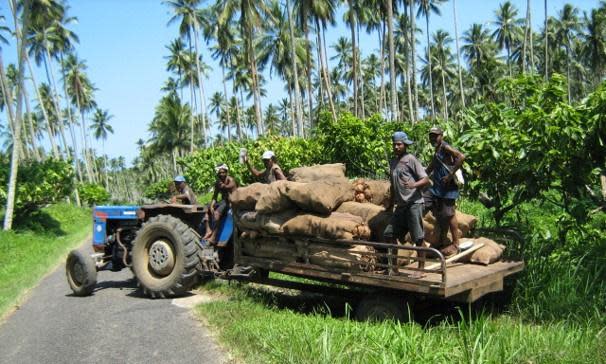How the humble coconut is starting to fuel parts of Papua New Guinea

On Karkar island in Papua New Guinea, hundreds of coconut trees stand tall, stretching far into the distance.
Decades ago, the fruit was a lucrative export but over the years it has become less prized on international markets. Now, the small island off the north coast of the country, is putting coconuts to another use.
The oil from copra – the white flesh from the coconut – is used to produce biodiesel, a renewable fuel made from biological sources, such as vegetable oils or animal fats. On Karkar that fuel is helping to power schools, hospitals and cargo ships.
Related: Happy, faithful and tied to nature: life adapting to the climate crisis – photo essay
It is made at the Kulili plantation, a large estate with roughly 980 hectares filled with coconut trees and cocoa plants that spread across the island. Derek Middleton, the managing director at Kulili, says they are producing 600,000 litres of coconut-based biofuel each year.
The project began in 2007, when Kulili developed a small facility to produce coconut biodiesel. Over the years it has proved successful and the operation has been growing ever since. Middleton is now trying to secure backing to expand the project and increase production.
“[The fuel] is used on Karkar in government vehicles, ambulances, police cars, motor vehicles, ships, generators and our own business,” says Middleton.
Other countries in the Pacific including Vanuatu and Fiji have developed similar, small-scale projects and conducted research into using coconut biodiesel as an alternative to traditional fuels, such as diesel.
In many instances, coconut biodiesel has replaced the use of diesel on Karkar and the fuel is sold cheaply to people on the island.
Now, the country’s leading science institute, PNG University of Technology (Unitech), is researching how coconut biodiesel could be used more widely as an alternative fuel. In particular, they are exploring if it can be developed and used across Madang province, where Karkar is located, especially in rural and remote communities.
Middleton says expanding the local industry would further reduce dependence on costly imports of fuels, but securing backing to grow the operation has proved challenging.
Economist Maholopa Laveil says in Papua New Guinea, provided the investments are profitable and sustainable, development partners may be needed and “the positive social impact would be undeniable”.
Turning coconut into fuel
Turning coconut into biodiesel has a history in Papua New Guinea – as well as Madang, it was used by revolutionary forces in Bougainville during the crisis in the 1980s and 1990s.
The process to make the biodiesel involves breaking down the coconut oil by first shredding high quality copra that is pushed through machines to squeeze out the oil. It is then mixed with lye and alcohol, and goes through chemical processes to create the biofuel, Unitech says. The university says when used alone, biodiesel is a more environmentally friendly form of fuel.
“It’s just diesel but rather than using crude oil, we use coconut oil in the process of making it,” says Middleton, adding that it can be used alone or blended with traditional fuels – without the need to modify engines.
Middleton says biodiesel has replaced about 50,000 litres of fuel each month, but that about 25,000 litres of traditional fuel is still imported.
At present all the coconuts used are sourced from Kulili. The plantations have been in the hands of the Australian-PNG Middleton family since the 1920s when William Middleton acquired it after his service in the first world war. Now it is run by his grandsons, Derek and Brett Middleton. Cocoa is the main export product while it is also focused on growing the coconut biofuel operation.
Middleton says with more funding the project could see enough fuel produced to supply the rest of Madang province – home to about 500,000 people. Kulili has approached the Madang government about expanding the project, and says there has been some interest. The Madang authorities didn’t respond to requests for comment.
Laveil says developing biofuels could bring benefits to the region, including the potential to employ more people, provided there are avenues for unskilled employment and training. He says for Madang, the immediate benefits would be increased goods and services taxes if more people were employed in the sector.
The Kulili project could be an example for the region more broadly, Laveil says, describing it as a “good example of the transition to green energy, and a locally driven alternative, and hopefully a successful business model”.
He says getting volume and quality to levels at which it may be exported could take years and significant investment, but with local government support it should be feasible.
“For the initial stages of the establishment of biofuel creation, not only coconuts, but sugar and others, I see the fuel, if it meets industrial and regulatory standards, meeting domestic markets before it enters international markets,” says Laveil.


